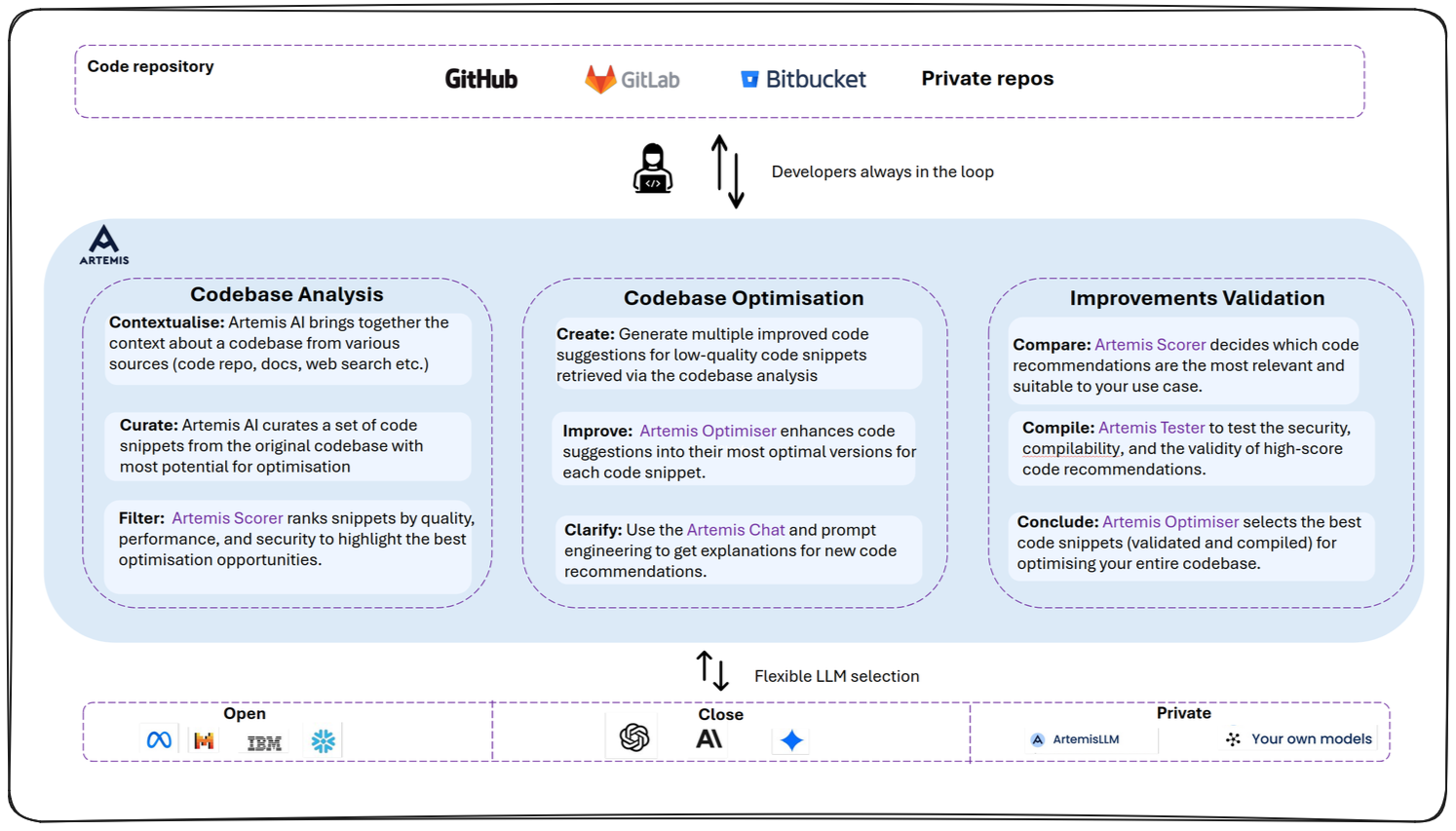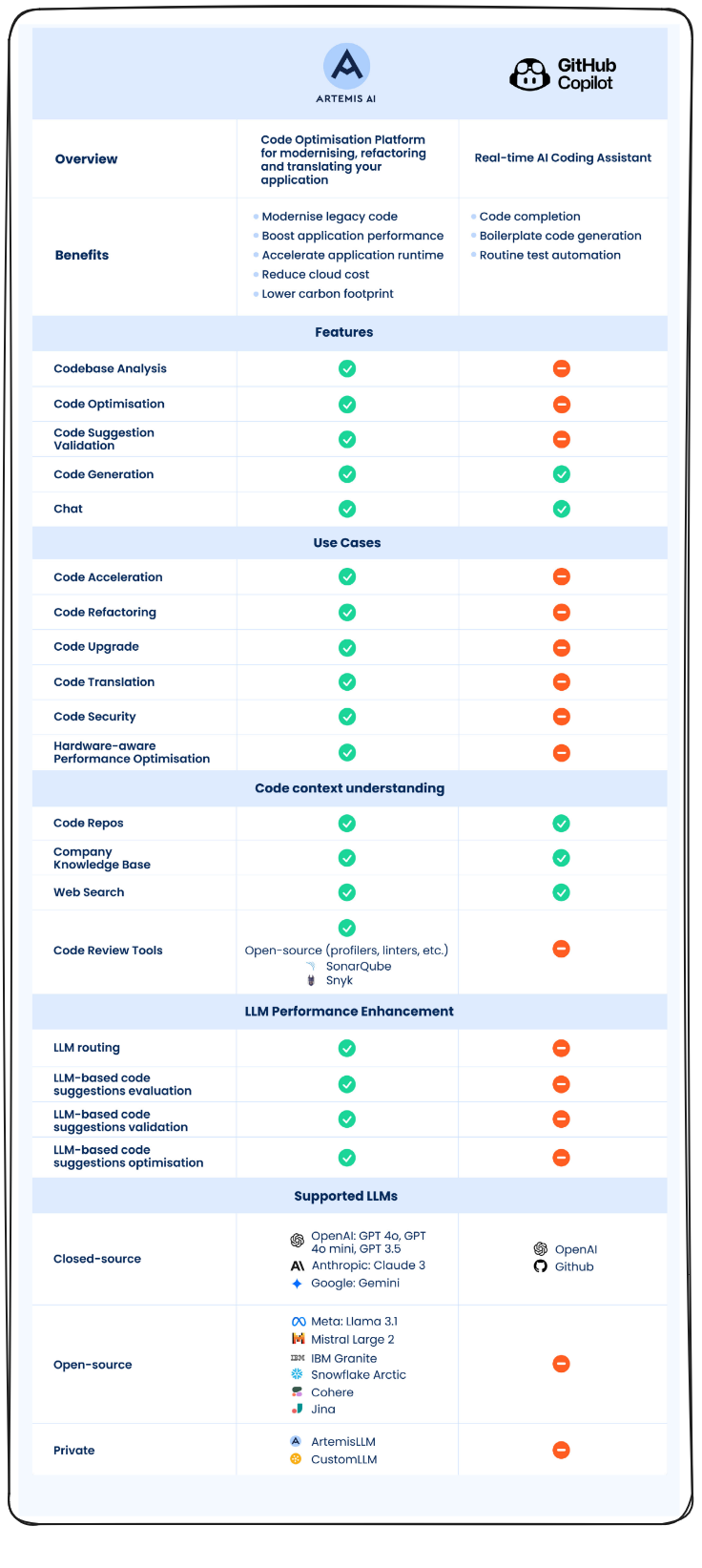FAQs
Artemis value-add
I can get ChatGPT to rewrite my code, why should I use Artemis?
The value-add in Artemis is in the scalability and credibility Artemis adds to the code reworking process.
While you can get ChatGPT to rewrite code, this means copying lines of code or uploading code file-by-file to ChatGPT and ctrl+c/ctrl+v-ing the reworked code back on to your codebase. This is rather cumbersome, and at the same time you have no way to verify if the code you receive is
accurate.
Artemis lets you scan entire codebases, retrieve sub-optimal code, prioritise which parts of the codebase to rework, receive improved code suggestions, and evaluate them for backward compatibility, functional correctness, security, and performance.
We visualised this to make it clearer:

What's the difference between Artemis and Github Copilot?
See the breakdown below:

Programming Languages
Which programming languages does Artemis support?
Python, C++, C, Fortran, Java, JavaScript, TypeScript, Ruby, PHP, C#, Go, Swift, Kotlin, Scala, Rust, Dart, R, Lua, Perl, SQL, Elixir, Plain Text, Q, COBOL, OCaml.
Working with LLMs
What does Artemis do to ensure that LLM output is accurate and valid?
Artemis has incorporated a set of scorers, which check the code output of LLMs for selected criteria. See the metrics we use for scoring here: Evaluate code versions. Further, we include validation tools to ensure that code will compile. These do a check of accuracy and validity of the code output. However, we also strongly advice users to check LLM output to ensure that the code versions meet the accuracy, quality, and validity standards against their own criteria.
What does Artemis do to mitigate LLM hallucinations?
We use multiple LLMs to generate responses, which allows us to gauge LLM output against each other. As it is highly unlikely for all LLMs to hallucinate the same way, it is easy to filter out misleading information. We also use scoring and validation techniques to evaluate the quality of the code output generated by LLMs, so that even if invalid code output is produced, they are filtered out before proceeding to next stages of the software development lifecycle.
What does Artemis do to mitigate any risks of unfairness, bias, toxicity, abuse, or misinformation?
For code output, we include scoring and validations to check on the functional accuracy and security of the code. For the chat components, Artemis often looks at a set of code files and documents provided as sources, so that the LLMs have high-quality material to extract information. However, we do not have control over the training material used during the training process of the LLMs, and as such are unable to completely remove harmful content.
What does Artemis do to prevent copyrighted material from being generated by LLMs and included in LLM outputs?
Artemis is able to integrate third-party tools into the platform, including tools that can monitor plagiarism in code. Based on user needs, we are able to integrate such tools into specific installations of Artemis. However, we do not have control over the training material used during the training process of the LLMs, and therefore are unable to completely guarantee the prevention of copyrighted material seeping into LLM output.
Can Artemis change my code without my knowledge?
No, Artemis takes a developer-in-the-loop approach to code optimisation, which means a user has complete control to decide whether or not to incorporate a code change into the codebase. We provide a suite of tools to help users make informed decisions about incorporating code changes into codebases, and further encourage users to make their own accuracy and validation checks.
Deployment
How can I get access to Artemis?
See details on our Deployment options page.
What infrastructure do I need to install Artemis?
This depends on the nature of your deployment. For on-premise deployments, see minimum and recommended requirements on our On-premise deployment page.
How much time does it take to deploy Artemis?
This will largely depend on your infrastructure and preferred mode of deployment, but roughly,
- Online deployment: 15-40 minutes
- Offline deployment: 45 minutes-1 hour
Technical details
How do you ensure data encryption at rest and in transit?
For data in transit, communication between services happens in an isolated network environment, so data transmission is secure. For efficiency, we don't encrypt data by default, but can do so based on client requirements.
What are the authentication mechanisms used?
The system relies on a custom OAuth2 server flow. The authentication mechanism supports the following grants and features:
- Password Grant: Enables user login using password credentials.
- Refresh Token Grant: Allows users to obtain a new access token through a refresh token.
- Client Credentials Grant: Facilitates machine-to-machine authentication.
- JWT Usage: Enhanced security is achieved through the use of JSON Web Tokens (JWT), incorporating scopes and permissions for controlled access.
- LDAP Integration: Additionally, custom LDAP authentication is supported, providing an additional layer of security within this mechanism.
How is role-based access control (RBAC) implemented and managed?
Role-Based Access Control is implemented with three distinct user roles, each with specific permissions and responsibilities.
What is your backup frequency and retention policy?
This depends on each client installation. We allow the flexibility to the client to choose preferred data backup frequency and policies for data retention.
What are your monitoring tools and practices?
- Sentry for live logs, if enabled on the client side.
- Kubernetes Dashboard that can monitor all services.
How do customers access performance and usage reports?
Clients can access either Sentry or the Kubernetes dashboard, and they are also able to access all this information in the platform itself.
What are the security and compliance certifications you hold (e.g ISO/IEC 27001)?
We are in the process of getting ISO/IEC 27001 and SOC2 certifications. We follow industry best practice in securing our platform. We continuously scan all our code, all the external dependencies used in the platform, and all the pre-built images. See more information on security scanning of images here: Artemis security scanning.
Data privacy
Does Artemis store my data?
For web-based users, TurinTech is able to access user and usage details, and additional details about your code projects.
With on-premise deployments, TurinTech teams cannot view or access any information.
Customer support
What are your customer support hours and channels?
Artemis has a built-in customer support portal that allows users to directly send across queries/report bugs. Alternatively, support queries can also be sent to support@turintech.ai. We aim to respond to all queries within 2 business days. Additionally, we provide a dedicated contact point (available via email/Microsoft Teams/Slack) to enterprise clients. The dedicated support personnel will work with enterprise clients to see how the platform can fit to specific workflows and use cases.
Write to us at support@turintech.ai. We aim to respond within 2 business days.